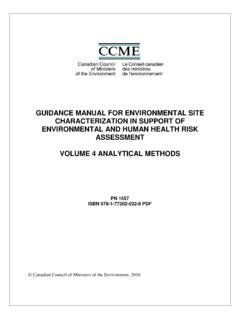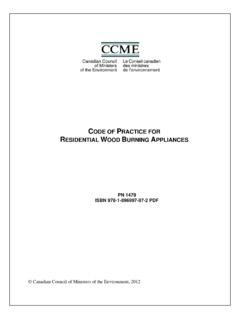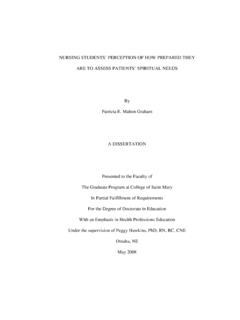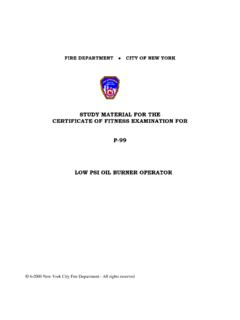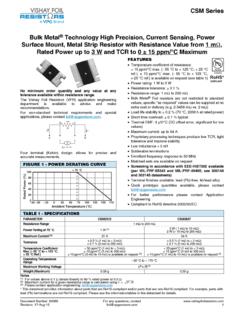Transcription of Canada-wide Standards for Petroleum Hydrocarbons (PHC) …
1 Canadian Council of Ministers of the Environment Canada-wide Standards . for Petroleum Hydrocarbons (PHC) IN SOIL. Endorsed by CCME Council of Ministers, April 30-May 1, 2001, Winnipeg 1 of 8. Table 1 Revised January 2008. Canada-wide Standards . for Petroleum Hydrocarbons (PHC) IN SOIL. These Canada-wide Standards (CWS) for Petroleum Hydrocarbons in soil are established pursuant to the 1998 Canada-wide Accord on Environmental Harmonization of the Canadian Council of Ministers of the Environment (CCME) and its Canada-wide Environmental Standards Sub-Agreement.
2 The PHC CWS is a remedial standard for contaminated soil and subsoil occurring in four land use categories. The standard is grounded in the science of risk assessment and can be applied at any of three Tiers : Tier 1 generic numerical levels; Tier 2 . adjustments to Tier 1 levels based on site-specific information; Tier 3 site-specific risk assessment. The same high level of environmental and human health protection is required at all three tiers. Because the PHC CWS is tiered and risk-based there is necessarily some complexity in its development and application.
3 Details regarding development and application of the Standards are provided in a Technical Supplement. The PHC CWS was developed with the input of four multistakeholder technical advisory groups and one dedicated working group involving the Canadian oil and gas industry, government and an academic chair. The PHC CWS represents a consensus view of the national Development Committee, developed with the assistance and input of the technical advisory groups. RATIONALE. Petroleum Hydrocarbons (PHC) are used in nearly every facet of Canadian life. They provide energy to heat our homes and places of work, fuel our transportation systems, power manufacturing processes and tools, as well as providing a source for the numerous synthetic materials we take for granted in our lives.
4 Used as intended, PHC provide great benefits to society. However, when released to the soil environment as raw feedstocks or refined fuels or lubricants, a number of problems can result. These include fire/explosion hazard, human and environmental toxicity, movement through soil to air or water, odour, and impairment of soil processes such as water retention and nutrient cycling. About 60% of Canada's contaminated sites involve Petroleum hydrocarbon (PHC). contamination that, left unaddressed, impairs the quality and uses of both land and water. Presently, management of these sites across Canada varies considerably and generally lacks an adequate scientific basis resulting in over- and under-management.
5 Where over-management occurs, land sale transactions and real estate redevelopment are limited by remediation costs. Under-managed sites continue to pose risks to human and environmental health. The PHC Canada-wide Standard will provide a consistent approach to managing PHC-contaminated sites across the country. Endorsed by CCME Council of Ministers, April 30-May 1, 2001, Winnipeg 2 of 8. Table 1 Revised January 2008. DEFINITIONS. Petroleum Hydrocarbons (PHC) is a general term used to describe mixtures of organic compounds found in or derived from geological substances such as oil, bitumen and coal.
6 For the purposes of this CWS, PHC are considered to be comprised of 4 fractions as defined in Part 1. PHC exclude for the purposes of this standard known carcinogens such as benzene and benzo(a)pyrene, which are addressed as target compounds. Because of the relatively long history of managing toluene, ethylbenzene and xylenes ( TEX ) as target compounds, these are also excluded from PHC. CONTEXT. Petroleum products released to the environment typically contain thousands of compounds, in varying proportions, composed predominantly of carbon and hydrogen, with minor amounts of nitrogen, sulphur and oxygen.
7 The properties of PHC. contamination in soils varies with the Petroleum source, soil type, the composition, degree of processing (crude, blended or refined), and the extent of weathering caused by exposure to the environment. The complexity of PHC, and the extreme variability of sources and site-specific circumstances, complicates assessment of the human and environmental health risks associated with PHC contamination in soil. PHC contamination in soil is a concern for a number of reasons. First, the chemically reactive nature and volatility of PHC can pose a fire/explosion hazard, especially if vapours enter confined spaces.
8 Second, most PHC constituents are toxic to some degree. Third, lighter Hydrocarbons ( those of lower molecular weights) are mobile and can become a problem at considerable distances from their point of release due to transport in ground, water or air. Fourth, larger and branched-chain Hydrocarbons are persistent in the environment. Fifth, PHC may create aesthetic problems such as offensive odour, taste or appearance in environmental media. Finally, under some conditions, PHC can degrade soil quality by interfering with water retention and transmission, and with nutrient supplies.
9 Canadian regulatory agencies have responded to these concerns with assessment and remediation requirements where PHC contaminate soils and groundwater. A blend of generic guidelines and site-specific, risk-based approaches has emerged across Canada, but there is very little consistency across jurisdictions in the rationale for guidelines, numerical values provided, or application to land uses. Endorsed by CCME Council of Ministers, April 30-May 1, 2001, Winnipeg 3 of 8. Table 1 Revised January 2008. The CWS is founded on documented and scientifically defensible risk-based methodology, namely the CCME Protocol for the Derivation of Environmental and Human Health Soil Quality Guidelines and the American Society for Testing & Materials (ASTM) Risk-based Corrective Action (RBCA) - and additions/improvements thereon, including the Atlantic Partners in RBCA Implementation (PIRI) (see Technical Supplement, section 1).
10 Consequently, the derivation of the CWS involves explicitly listed receptors - both human and ecological, and the levels of protection accorded. It also involves defined exposure scenarios, and documented underlying assumptions, equations and policies (see Technical Supplement, sections 1 and 2). Moreover, a vast array of analytical chemistry options exists for quantifying Hydrocarbons in soil. Various methods have been developed to measure most or part of the Hydrocarbons present in a sample based on different sampling, storage, extraction, purification, quantification, and data treatment approaches.
